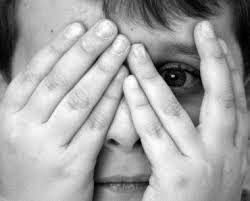The scariest places are
not in the outer world. Yes, we
are often afraid of spiders or clowns or heights or flying, but the really
hard-to-deal-with fears are internal.
Terrors that are often nameless, shapeless things that loom and hover in
our psychic space.
Fear is instinctual, and essential to our survival, and yet for many of us, self preservation is not at the essence of our tremors. Maybe if we think of it as survival of the ego, we can begin to understand the deeper and perhaps scarier fears that we carry. "Am I loved?" "Do I matter?"
"Will I ever be happy?" "What happens when I die?" These are the kinds of thoughts that live underneath our scariest places.
"Will I ever be happy?" "What happens when I die?" These are the kinds of thoughts that live underneath our scariest places.
We also live in a society
where feelings in general, and certainly what we would consider the “bad”, “dark”, or “hard” ones are not easy for
us to express or hear expressed. It
is Ok to be happy, or sad, but not so easily are we invited to be downright
afraid or angry. The cultural
message is usually to CALM DOWN or RELAX!
 Fear and pain are
generally what lies beneath anger and rage. We find that when people develop a stronger sense of
belonging, social connections and meaning in the their lives, fears are diluted
and carry less weight.
Fear and pain are
generally what lies beneath anger and rage. We find that when people develop a stronger sense of
belonging, social connections and meaning in the their lives, fears are diluted
and carry less weight. The internal fears are
important to name. EMPTINESS. DISCONNECTION. ISOLATION/LONELINESS. SORROW.
LOSS OF MEANING/VALUE. DEATH.
The internal fears are
important to name. EMPTINESS. DISCONNECTION. ISOLATION/LONELINESS. SORROW.
LOSS OF MEANING/VALUE. DEATH.
Notice how you feel
reading this list. That feeling of
discomfort is a tinkling reminder of fear.
 We don’t have to take
them all on today. Most cognitive
behavior therapy for phobias or anxiety use EXPOSURE THERAPY, which is process
of developing a “bravery ladder” beginning with ideas and moving towards more
exposure or actual experience of something. As we survive these moments of increasing experience, we
become more courageous, confident and brave.
We don’t have to take
them all on today. Most cognitive
behavior therapy for phobias or anxiety use EXPOSURE THERAPY, which is process
of developing a “bravery ladder” beginning with ideas and moving towards more
exposure or actual experience of something. As we survive these moments of increasing experience, we
become more courageous, confident and brave.
 Whether we are working on
a fear of flying or fear of feeling sad, it is important to continue on the
path, allowing ourselves to feel, for just a moment something difficult. In one of my favorite Paul Newman
movies, NOBODY’S FOOL, there is a scene where his character, Sully, is teaching
his grandson to be brave by giving him a stopwatch and encouraging him to be
brave for one minute. Pema
Chodron, in her book FROM FEAR TO FEARLESSNESS, describes a practice of feeling
something difficult for just moments, breathing into that experience, feeling
it as deeply as you are able to, and then releasing it. Slowly, over time we develop that
unused emotional muscle to make it strong enough to contain and withstand our
fears. As we do this, the fear
then is allowed to transform into a more active, rather than frozen response.
Whether we are working on
a fear of flying or fear of feeling sad, it is important to continue on the
path, allowing ourselves to feel, for just a moment something difficult. In one of my favorite Paul Newman
movies, NOBODY’S FOOL, there is a scene where his character, Sully, is teaching
his grandson to be brave by giving him a stopwatch and encouraging him to be
brave for one minute. Pema
Chodron, in her book FROM FEAR TO FEARLESSNESS, describes a practice of feeling
something difficult for just moments, breathing into that experience, feeling
it as deeply as you are able to, and then releasing it. Slowly, over time we develop that
unused emotional muscle to make it strong enough to contain and withstand our
fears. As we do this, the fear
then is allowed to transform into a more active, rather than frozen response.

Just for today, let yourself be afraid. Just a little, just for a moment, then BREATHE, and again BREATHE, and then maybe LAUGH!





No comments:
Post a Comment